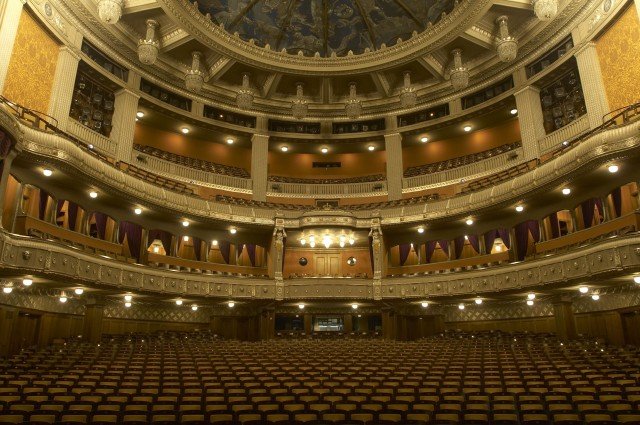
Story by Carola Meusel
USAG Stuttgart Public Affairs Office
A night at the Stuttgart Opera is more than an evening filled with music in an elegant setting: It is a place where history, dance and culture meet.
Its history dates back to 1912, when the newly constructed “Königliches Hoftheater,” or Royal Court Theater, was officially opened as a “double-theater,” with a “Grosse Haus” (opera) and “Kleine Haus” (theater). During the 1930s, Stuttgart’s theater officially became the “Württembergische Staatstheater,” or State Theater.
The State Theater House was completely destroyed by bombs in World War II, but the Opera House was one of a handful of buildings left intact. It’s said that U.S. Soldiers played pingpong at the opera when the military government of Württemberg- Baden used it as a temporary headquarters in the summer 1945 before it moved to its permanent location at Olgastrasse, today’s U.S. Forces Liaison Office. At that time, the opera also served as a “Crossroads” recreation center of the American Red Cross.
On Sept. 6, 1946, U.S. Secretary of State James F. Byrnes delivered his famous “Speech of Hope,” or Stuttgart Speech, at the Stuttgart State Theater. In his speech, Byrnes promised that Germany would be rebuilt and not divided economically, and that Germans would be allowed to govern themselves democratically. The speech set course for post-war engagements between the U.S. and Germany. Today, a plaque in the main foyer of the building commemorates this historic event.
The U.S. Forces assigned the former artistic director of the State Theater to start rebuilding the Theater House.
Now, the theater has three distinct sections: the opera, the theater and the Stuttgart Ballet. With all of the sections, it is considered one of Europe’s largest theater houses, according to Thomas Koch, director of the opera’s communication department.
The Stuttgart Opera is also one of the most popular in Europe, he added.
Between now and July, the Stuttgart Opera features world famous productions including Georges Bizet’s “Carmen,” Giacomo Pucchini’s “Tosca” and Gioachino Rossini’s “Il Barbiere Di Siviglia.”

Most productions are accompanied by the State Orchestra and the State Opera Choir. The orchestra was established 424 years ago. The choir is known as one of the most popular opera choirs in European music theater and earned the title of “Opera Choir of the Year” nine times, and the Opera House was named “Opera House of the Year” six times.
“The theatrical setup, the music and the opera singers are simply impressive,” said Rolf Huhnke, from Stuttgart, who attends the Stuttgart Opera frequently.
Huhnke said he was swept away by the music. Between the musicians and the opera hall’s setup, the sounds fill the theater to the rafters.
“Personally, I am a big fan of Italian operas,” he added.
Koch, the Opera House spokesman, recommends visiting the opera for a guided tour to learn more about its history and see the backstage area.
Visitors can learn a lot about the technique, stage design and settings, costume making and all the studios that support the productions with their work and expertise, according to Koch.
Opera tickets range from €8-115, depending on the seats guests choose. The lower priced tickets provide a way for visitors of all economic standings the opportunity to see a production.
According to Koch, the intent is to offer opera tickets, which have the same price as a ticket to the movie theater, as everybody should be able to visit the Stuttgart Opera to enjoy its productions.
Hear more about Stuttgart’s opera during AFN Stuttgart’s Morning Show “Culture Corner,” March 10 and March 17, from 8-9 a.m., as we’ll talk to American opera singers which are part of the opera’s ensemble and perform in current productions. Stay tuned on 102.3 FM, or AFN Stuttgart 360 Internet radio if you already are at your desk.
For more information in English on the Stuttgart Opera and its program, visit here. Tickets can be purchased by calling 0711- 20-2090. For guided tours in English, call civ. 0711-203-2644.
